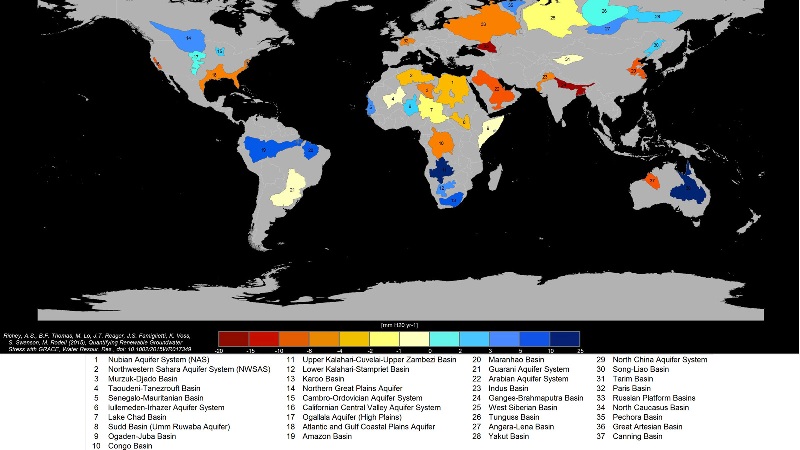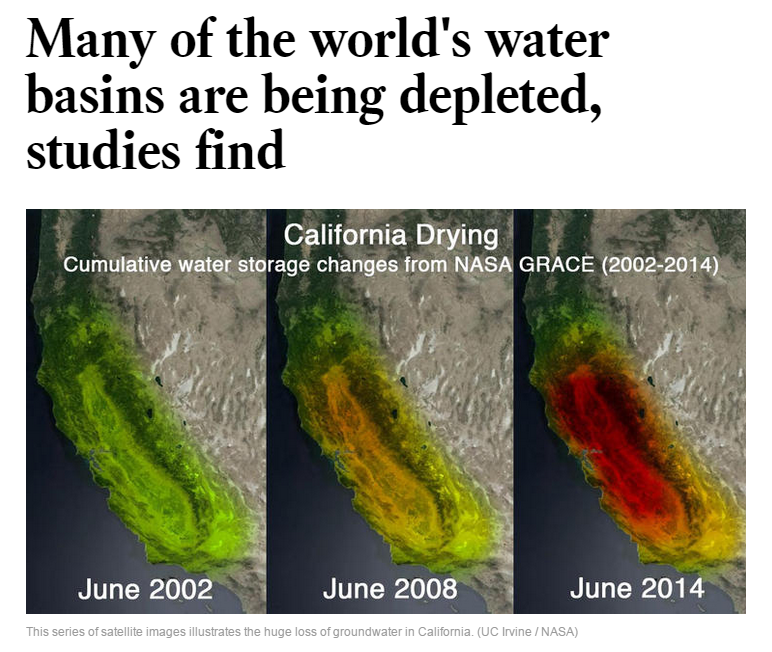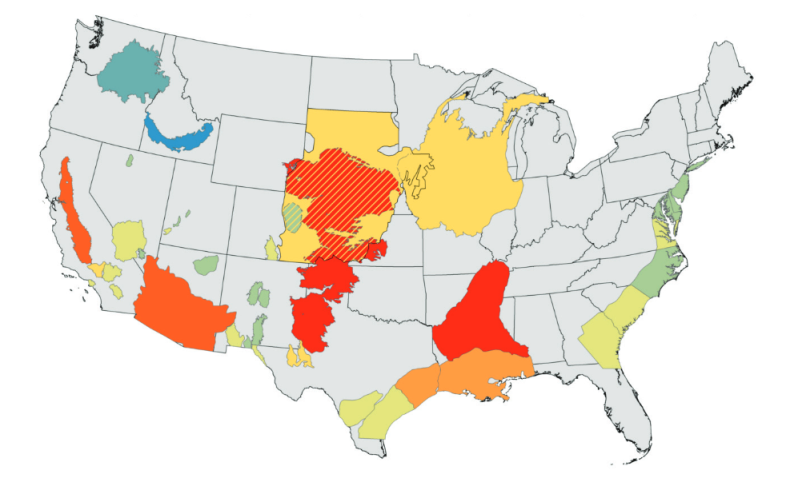Aquifers: Difference between revisions
Siterunner (talk | contribs) No edit summary |
Siterunner (talk | contribs) No edit summary |
||
| (29 intermediate revisions by the same user not shown) | |||
| Line 1: | Line 1: | ||
<big>'''''Aquifers at Risk'''''</big> | |||
○ ○ | ''Rapacious Taking of Water Resources'' | ||
2023 | |||
<big>'''''"America Is Using Up Its Groundwater Like There’s No Tomorrow"'''''</big> | |||
[https://www.nytimes.com/interactive/2023/08/28/climate/groundwater-drying-climate-change.html?unlocked_article_code=Xw4zaSceJ70Cp7sdE2owc2CGJrktUiyNWMfhvBc3V17Zxf9-U6N_VO83T__6nQumOoKJ88khIfoHotfaQx7Tsi3hY8qez_G7XkWxi0BhFDZWqNLxIwSS9pkcs4BVfsvjhzWVNRlVj9plQ3amNuHPjkqfRP4vgIxfLUm2u9WtBb6oaSq6ID9EuNx52entu11Ca6-bwNbC2WlTyrlFkEiHalv20Y665X0lyCut86rBkyni1YOEgpo3oiAlj1WY8oKCLuwNNVdCoXyKu56p16xX5UQgydC7CZQHXF9ZsvOMky2PEvYW9AZjgV-AGabfuf4_hoqsjxjklSQG7z08oj1GUei3QWE-UPqtNOK-SqO4eKrBIr__M9plQFtolA&smid=url-share ''Read the Report on the Draining of US Aquifers''] | |||
''Overuse is draining and damaging aquifers nationwide, a New York Times (2022) data investigation reveals'' | |||
○ | |||
'''GreenPolicy360 says 'water is life' and nations of the world must protect and sustain fresh water resources:''' | |||
: '''Climate Change and Drought, Non-sustainable Overuse of Water | |||
[http://www.greenpolicy360.net/w/Earth_Science_Research_from_Space '''Measure, Monitor, Manage Aquifers -- Earth Science Research from Space'''] begins to monitor and demonstrate depletion of fresh water sources. | |||
''November 2015 / For the first time since 'back-of-the-envelope' estimates of groundwater use were calculated in the 1970s,'' [http://phys.org/news/2015-11-earth-hidden-groundwater.html '''''"hydrologists have produced a first 'data-driven estimate' of the Earth's total supply of groundwater..."'''''] | |||
''The challenge going forward is to develop systems that are improved to continuously monitor the use of water -- depletion and recharging-resupply -- and the social systems that are capable of developing and employing [http://www.greenpolicy360.net/w/Category:Ecological_Economics ecological economics], production systems to maintain ongoing fresh water for all needed uses, from agriculture to home, personal to business.'' | |||
○ | |||
:'''''Click on maps and graphics''''' | |||
[[File:Groundwaterstudy 1.png]] | |||
[[File:Aquifers global earth observations by grace20150616-16 m.jpg | link=http://www.jpl.nasa.gov/news/news.php?feature=4626]] | [[File:Aquifers global earth observations by grace20150616-16 m.jpg | link=http://www.jpl.nasa.gov/news/news.php?feature=4626]] | ||
''''' | [[File:You can manage only what you can measure Dr David Crisp, OCO-2, June 2014 m.jpg]] | ||
<big><big>'''''First Global Study of Aquifers from Space'''''</big></big> | |||
[http://onlinelibrary.wiley.com/doi/10.1002/2015WR017349/abstract ''"Quantifying renewable groundwater stress with GRACE", 16 June 2015''] | [http://onlinelibrary.wiley.com/doi/10.1002/2015WR017349/abstract ''"Quantifying renewable groundwater stress with GRACE", 16 June 2015''] | ||
''The '''GRACE earth observation system (EOS)''' mission is to measure gravity variations including: | ''The '''GRACE earth observation system (EOS)''' mission is to measure gravity variations including: | ||
| Line 26: | Line 62: | ||
''"The results from GRACE make a huge contribution to NASA's Earth science goals, Earth Observation System (EOS) and global climate change studies."'' | ''"The results from GRACE make a huge contribution to NASA's Earth science goals, Earth Observation System (EOS) and global climate change studies."'' | ||
○ ○ ○ ○ ○ ○ ○ ○ ○ ○ ○ ○ ○ ○ ○ ○ ○ | |||
○ ○ ○ ○ ○ ○ ○ ○ ○ ○ ○ ○ ○ ○ ○ ○ ○ | |||
<big>'''''Earth Aquifer Observations / June 2015'''''</big> | <big>'''''Earth Aquifer Observations / June 2015'''''</big> | ||
| Line 38: | Line 76: | ||
'''''“The situation is quite critical,” said Jay Famiglietti, senior water scientist at NASA’s Jet Propulsion Laboratory in California and principal investigator of the University of California Irvine-led studies.''''' | '''''“The situation is quite critical,” said Jay Famiglietti, senior water scientist at NASA’s Jet Propulsion Laboratory in California and principal investigator of the University of California Irvine-led studies.''''' | ||
''Famiglietti said problems with groundwater are exacerbated by global warming, which has caused the regions closest to the equator to get drier and more extreme latitudes to experience wetter and heavier rains. A self-reinforcing cycle begins. People living in mid-range latitudes not only pump more water from aquifers to contend with drier conditions, but that water — once removed from the ground — also then evaporates and gets recirculated to areas far north and south... | ''Famiglietti said problems with groundwater are exacerbated by global warming, which has caused the regions closest to the equator to get drier and more extreme latitudes to experience wetter and heavier rains. A self-reinforcing cycle begins. People living in mid-range latitudes not only pump more water from aquifers to contend with drier conditions, but that water — once removed from the ground — also then evaporates and gets recirculated to areas far north and south... | ||
○ | ○ | ||
'''''Underground aquifers supply 35 percent of the water used by humans worldwide...''''' | '''''Underground aquifers supply 35 percent of the water used by humans worldwide...''''' | ||
| Line 49: | Line 88: | ||
''“This has really been our first chance to see how these large reservoirs change over time,” said Gordon Grant, a research hydrologist at Oregon State University, who was not involved in the studies... | ''“This has really been our first chance to see how these large reservoirs change over time,” said Gordon Grant, a research hydrologist at Oregon State University, who was not involved in the studies... | ||
[[File:Aquifers globalstudy 2015.png]] | [[File:Aquifers globalstudy 2015.png]] | ||
○ | ○ | ||
''Many previous studies of groundwater storage relied on statistical calculations and looked mostly at how much water was being pumped from the ground. These limited estimates were too uncertain to improve groundwater management, researchers said. For example, past storage estimates for the Northwest Sahara Aquifer System ranged from 10 to 21,000 years. | ''Many previous studies of groundwater storage relied on statistical calculations and looked mostly at how much water was being pumped from the ground. These limited estimates were too uncertain to improve groundwater management, researchers said. For example, past storage estimates for the Northwest Sahara Aquifer System ranged from 10 to 21,000 years. | ||
| Line 61: | Line 103: | ||
'''''The twin satellites — known as Gravity Recover and Climate Experiment, or GRACE, satellites — orbit the Earth and measure the gravitational pull of water over time. The difference in measurements over time shows how much water the aquifers are gaining or losing...''''' | '''''The twin satellites — known as Gravity Recover and Climate Experiment, or GRACE, satellites — orbit the Earth and measure the gravitational pull of water over time. The difference in measurements over time shows how much water the aquifers are gaining or losing...''''' | ||
○ | ○ | ||
○ ○ ○ ○ ○ ○ ○ | [http://www.eoearth.org/view/article/150159/ ''Aquifer depletion and solutions''] ''http://earthsky.org/human-world/bridget-scanlon-on-the-accelerating-depletion-of-groundwater-worldwide -- http://web.mit.edu/12.000/www/m2012/finalwebsite/solution/groundwater.shtml -- http://news.utexas.edu/2012/05/29/groundwater'' | ||
'''''Aquifers'''''-- https://en.wikipedia.org/?title=Aquifer | |||
<big>''Industrial agriculture globally: Water and Agriculture''</big> | |||
''One of the issues rarely confronted when considering high intensive agriculture is the use of water in unsustainable irrigation. The draw down and depletion of aquifers is a rising cost and only recently, with the advent of earth observation and monitoring systems, are technologies becoming available to measure the extent of groundwater basins and recharging capabilities. The new satellite measurements of aquifers/ground water globally, as are now being reported with NASA GRACE satellites, comprise both a warning and a capability of needed sustainable environmental security. Water saving and water security are essential to a lasting agriculture policy...'' | |||
○ ○ ○ ○ ○ ○ ○ | |||
[[File:Aquifers June2015 past the tipping point.png]] | [[File:Aquifers June2015 past the tipping point.png]] | ||
| Line 74: | Line 129: | ||
[[File:Water shortage 4B people sci report-2016.png]] | |||
○ | |||
<big>'''Drop in U.S. underground water levels has accelerated: USGS'''</big> | |||
:http://www.greenpolicy360.net/w/File:USGS_Groundwater_depletion_map_2013.png | |||
:http://research.msu.edu/saving-the-great-plains-water-supply-2/ | |||
:'''Large areas of the Ogallala Aquifer, one of the most important sources of water for agricultural crops in the United States, are at risk of drying up if the aquifer continues to be drained at its current rate.''' | |||
:The Ogallala, also known as '''the High Plains Aquifer (HPA), spans from Texas to South Dakota''' and provides water to grow $35 billion in crops each year. However, since the 1950s, when high-volume pumping began, the HPA’s saturated volume has declined by roughly the volume of Lake Erie...''' | |||
[[File:USGS Groundwater depletion map 2013.png]] | |||
[[Category:Agricultural Economics]] | |||
[[Category:Agriculture]] | |||
[[Category:Aquifers]] | [[Category:Aquifers]] | ||
[[Category:Citizen Science]] | [[Category:Citizen Science]] | ||
[[Category:Climate Change]] | [[Category:Climate Change]] | ||
[[Category:Climate Smart Agriculture]] | |||
[[Category:Desertification]] | |||
[[Category:Earth360]] | [[Category:Earth360]] | ||
[[Category:Earth Observations]] | [[Category:Earth Observations]] | ||
[[Category:Earth Science]] | [[Category:Earth Science]] | ||
[[Category:Earth Science from Space]] | [[Category:Earth Science from Space]] | ||
[[Category:Ecological Economics]] | |||
[[Category:Ecology Studies]] | |||
[[Category:Eco-nomics]] | |||
[[Category:Economic Development]] | |||
[[Category:Environmental Full-cost Accounting]] | |||
[[Category:Environmental Security]] | [[Category:Environmental Security]] | ||
[[Category:Environmental Security, National Security]] | [[Category:Environmental Security, National Security]] | ||
| Line 99: | Line 183: | ||
[[Category:Virtual Earth]] | [[Category:Virtual Earth]] | ||
[[Category:Virtual Planet]] | [[Category:Virtual Planet]] | ||
[[Category:US]] | |||
[[Category:Water]] | [[Category:Water]] | ||
[[Category:Water Quality]] | |||
[[Category:Water Saving]] | |||
[[Category:Wetlands]] | |||
[[Category:Whole Earth]] | [[Category:Whole Earth]] | ||
Latest revision as of 15:42, 3 September 2023
Aquifers at Risk
Rapacious Taking of Water Resources
2023
"America Is Using Up Its Groundwater Like There’s No Tomorrow"
Read the Report on the Draining of US Aquifers
Overuse is draining and damaging aquifers nationwide, a New York Times (2022) data investigation reveals
○
GreenPolicy360 says 'water is life' and nations of the world must protect and sustain fresh water resources:
- Climate Change and Drought, Non-sustainable Overuse of Water
Measure, Monitor, Manage Aquifers -- Earth Science Research from Space begins to monitor and demonstrate depletion of fresh water sources.
November 2015 / For the first time since 'back-of-the-envelope' estimates of groundwater use were calculated in the 1970s, "hydrologists have produced a first 'data-driven estimate' of the Earth's total supply of groundwater..."
The challenge going forward is to develop systems that are improved to continuously monitor the use of water -- depletion and recharging-resupply -- and the social systems that are capable of developing and employing ecological economics, production systems to maintain ongoing fresh water for all needed uses, from agriculture to home, personal to business.
○
- Click on maps and graphics
First Global Study of Aquifers from Space
"Quantifying renewable groundwater stress with GRACE", 16 June 2015
The GRACE earth observation system (EOS) mission is to measure gravity variations including:
- changes due to surface and deep currents in the ocean;
- runoff and ground water (aquifer) storage on land masses;
- exchanges between ice sheets or glaciers and the oceans; and
- variations of mass within the Earth.
An additional goal of the mission is to create a better profile of the Earth's atmosphere.
"The results from GRACE make a huge contribution to NASA's Earth science goals, Earth Observation System (EOS) and global climate change studies."
○ ○ ○ ○ ○ ○ ○ ○ ○ ○ ○ ○ ○ ○ ○ ○ ○
Earth Aquifer Observations / June 2015
The world’s largest underground aquifers – a source of fresh water for hundreds of millions of people — are being depleted at alarming rates, according to new NASA satellite data that provides the most detailed picture yet of vital water reserves hidden under the Earth’s surface.
Twenty-one of the world’s 37 largest aquifers — in locations from India and China to the United States and France — have passed their sustainability tipping points, meaning more water was removed than replaced during the decade-long study period, researchers announced Tuesday. Thirteen aquifers declined at rates that put them into the most troubled category. The researchers said this indicated a long-term problem that’s likely to worsen as reliance on aquifers grows.
Scientists had long suspected that humans were taxing the world’s underground water supply, but the NASA data was the first detailed assessment to demonstrate that major aquifers were indeed struggling to keep pace with demands...
“The situation is quite critical,” said Jay Famiglietti, senior water scientist at NASA’s Jet Propulsion Laboratory in California and principal investigator of the University of California Irvine-led studies.
Famiglietti said problems with groundwater are exacerbated by global warming, which has caused the regions closest to the equator to get drier and more extreme latitudes to experience wetter and heavier rains. A self-reinforcing cycle begins. People living in mid-range latitudes not only pump more water from aquifers to contend with drier conditions, but that water — once removed from the ground — also then evaporates and gets recirculated to areas far north and south...
○
Underground aquifers supply 35 percent of the water used by humans worldwide...
The researchers used NASA’s GRACE satellites to take precise measurements of the world’s groundwater aquifers. The satellites detected subtle changes in the Earth’s gravitational pull, noting where the heavier weight of water exerted a greater pull on the orbiting spacecraft. Slight changes in aquifer water levels were charted over a decade, from 2003 to 2013.
“This has really been our first chance to see how these large reservoirs change over time,” said Gordon Grant, a research hydrologist at Oregon State University, who was not involved in the studies...
○
Many previous studies of groundwater storage relied on statistical calculations and looked mostly at how much water was being pumped from the ground. These limited estimates were too uncertain to improve groundwater management, researchers said. For example, past storage estimates for the Northwest Sahara Aquifer System ranged from 10 to 21,000 years.
"This work clearly demonstrates that it is no longer adequate to continue citing decades-old ... estimates of total groundwater storage," according to the new studies, which were published in the journal Water Resources Research.
Richey's studies use 11 years of data from NASA satellites and include a number of other factors, such as population, climate and how people use water.
The twin satellites — known as Gravity Recover and Climate Experiment, or GRACE, satellites — orbit the Earth and measure the gravitational pull of water over time. The difference in measurements over time shows how much water the aquifers are gaining or losing...
○
Aquifer depletion and solutions http://earthsky.org/human-world/bridget-scanlon-on-the-accelerating-depletion-of-groundwater-worldwide -- http://web.mit.edu/12.000/www/m2012/finalwebsite/solution/groundwater.shtml -- http://news.utexas.edu/2012/05/29/groundwater
Aquifers-- https://en.wikipedia.org/?title=Aquifer
Industrial agriculture globally: Water and Agriculture
One of the issues rarely confronted when considering high intensive agriculture is the use of water in unsustainable irrigation. The draw down and depletion of aquifers is a rising cost and only recently, with the advent of earth observation and monitoring systems, are technologies becoming available to measure the extent of groundwater basins and recharging capabilities. The new satellite measurements of aquifers/ground water globally, as are now being reported with NASA GRACE satellites, comprise both a warning and a capability of needed sustainable environmental security. Water saving and water security are essential to a lasting agriculture policy...
○ ○ ○ ○ ○ ○ ○
○
Drop in U.S. underground water levels has accelerated: USGS
- http://www.greenpolicy360.net/w/File:USGS_Groundwater_depletion_map_2013.png
- http://research.msu.edu/saving-the-great-plains-water-supply-2/
- Large areas of the Ogallala Aquifer, one of the most important sources of water for agricultural crops in the United States, are at risk of drying up if the aquifer continues to be drained at its current rate.
- The Ogallala, also known as the High Plains Aquifer (HPA), spans from Texas to South Dakota and provides water to grow $35 billion in crops each year. However, since the 1950s, when high-volume pumping began, the HPA’s saturated volume has declined by roughly the volume of Lake Erie...
- Agricultural Economics
- Agriculture
- Aquifers
- Citizen Science
- Climate Change
- Climate Smart Agriculture
- Desertification
- Earth360
- Earth Observations
- Earth Science
- Earth Science from Space
- Ecological Economics
- Ecology Studies
- Eco-nomics
- Economic Development
- Environmental Full-cost Accounting
- Environmental Security
- Environmental Security, National Security
- EOS eco Operating System
- Geophysics and Geochemistry
- Geology
- Geophysics
- Hydrology
- Natural Resources
- Permaculture
- Planet API
- Planet Citizen
- Planet Scientist
- Planet Citizens, Planet Scientists
- Planetary Science
- Sustainability
- Sustainability Policies
- Virtual Earth
- Virtual Planet
- US
- Water
- Water Quality
- Water Saving
- Wetlands
- Whole Earth







